You can go far on a single Metrobus from LeDroit Park
How far can you go from LeDroit Park on a one-seat Metrobus or Metrorail ride? Pretty far, actually. The map above illustrates all the bus lines and metro lines that run through or near LeDroit Park. View an interactive version of the map.
Residents are fairly familiar with our Metrorail system, but may not know the far reach of the Metrobus network. From LeDroit Park you can board a single bus and go to 14th Street, Dupont Circle, Georgetown, Adams Morgan, Woodley Park, the National Cathedral, Union Station, H Street NE, Eastern Market, and Barracks Row and never worry about parking. There are also several buses that go downtown to destinations like Chinatown, the Archives, Metro Center, Farragut Square, Foggy Bottom, and the Kennedy Center.
Here’s a breakdown of routes by the destinations they serve.
West to Shaw, Logan Circle, Dupont Circle, and Georgetown
Board the G2 bus, which originates in LeDroit Park. You can also use this bus to carry heavy groceries from the Whole Foods on P Street or the Giant at 7th & O Streets.
West and north to U Street, Adams Morgan, Woodley Park, the National Cathedral, and Tenleytown
| Destination | 90,92,93 | 96 | X3 (rush) |
|---|---|---|---|
| Boarding point » | Florida Ave | Florida Ave., New Jersey Ave. |
Florida Ave |
| U Street | Yes | Yes | Yes |
| Adams Morgan | 90 & 93 | Yes | Yes |
| Woodley Park, National Cathedral, Tenleytown | Yes | Yes |
North to Petworth, Brightwood, and Silver Spring
Board the 70 bus or 79 express bus on Georgia Ave. For longer distances, board the 79 at Georgia and Florida Avenues (northbound). This bus makes fewer stops and doesn’t run on Sundays.
To Union Station, H Street NE, Capitol Hill, and east of the Anacostia
Ranked in relative order of speediness to the destination:
| Destination | 80 | 90,92,93 | 96 | X3 (rush) |
|---|---|---|---|---|
| Boarding point » | N. Capitol St. | Florida Ave. | Florida Ave, New Jersey Ave. |
Florida Ave |
| Union Station | 1 | 1 | ||
| H Street NE | 1 | 2 | ||
| Capitol Hill (the Capitol) | 2 | 1 | ||
| Capitol Hill (Eastern Market) | 1 | 2 | ||
| Capitol Hill (Barracks Row) | 1 | |||
| Capitol Heights | 1 | |||
| Historic Anacostia, Congress Heights | 1 |
To downtown
If you regularly ride Metro, you know the subway system occasionally breaks. If you’re looking for other routes to downtown or to other Metro lines, try these buses (ranked in relative order of speediness to the destination):
| Destination | G2 | G8 | 80 | 70,79 | 90,92,93 | 96 |
|---|---|---|---|---|---|---|
| Boarding point » | 3rd St, Elm St, V St | Rhode Is. Ave | N. Captiol St. | 7th St./Georgia Ave. | Florida Ave | Florida Ave, New Jersey Ave. |
| Foggy Bottom | 1 | |||||
| The Capitol | 2 | 1 | ||||
| Chinatown, Archives | 2 | 1 | ||||
| Dupont Circle | 1 | |||||
| Farragut Square | 1 | 2 | ||||
| McPherson Square | 1 | 2 | ||||
| Union Station | 1 | 1 |
See you on the bus!
Note: X3 runs along Florida Avenue, but only during rush hour. 79 is an express bus (it skips stops) that doesn’t run on Sunday.
7th & Florida in ’68, ’88, and today

What happened to all the historic buildings at 7th Street, Florida Avenue, and Georgia Avenue? We all recognize the CVS and its adjacent parking lot. As we reported before, the adjacent grassy field is slated for a residential development by JBG, one of the region’s largest development companies.
But how did the CVS, the parking lot, and the grassy field get there in the first place? They are the consequence of the 1968 riots and of the construction of the Green Line tunnels.
The riots of April 1968 destroyed many of the buildings along 7th Street. A few months ago we came across this photo in a Congressional report published in the wake of the riots. The west side of 7th Street from T Street to Florida Avenue was obliterated:
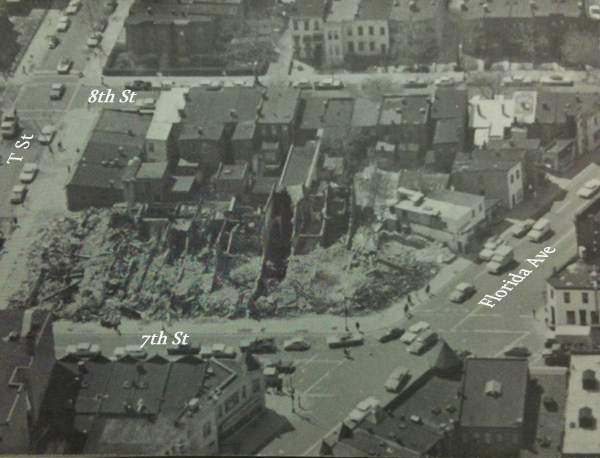
Decades later, the intersection sat at an elbow in the proposed Green Line tunnel. The subway line curves from 7th Street to Florida Avenue and then to U Street. Much of the line was constructed using the cut-and-cover method, which requires razing buildings, digging a trench, building a concrete box in the trench, and covering it back over.
Subway tunnels typically run under existing streets, but sharp changes in direction require cutting corners and thus the creation of tunnels where buildings often stand.
A 1988 photograph shows the construction of the Green Line tunnels, which pass under the CVS and adjacent lots.
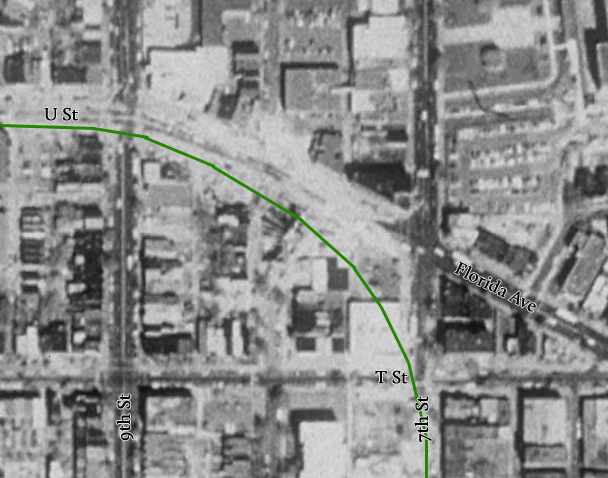
What the riots didn’t destroy, the Green Line took care of.
Metro station names get a little more rational
WMATA decided to revise our iconic Metro map to include the Silver Line and account for slight changes in rush-hour service on the Orange and Blue Lines. The new design, pictured above, ameliorates one of the agency’s usability problems: name sprawl. The new map wisely rearranges several station names to move the less important parts of sprawling names onto smaller subtitles.
When the system was built, station names were originally designed to be short and represent geographic places. Due to politics, local boosterism, and unwise interference from local politicians, some names have exploded in length. The U Street station name, “U Street/African-American Civil War Memorial/Cardozo”, is often cited as the poster child of clunky name sprawl. It wasn’t supposed to be this way. U Street as a place has a history and regional recognition strong enough to stand on its own. The station was originally listed as “U Street”, but then “Cardozo” got tacked on. Worse yet, in 1999 the DC Council voted (and paid) to change the name from “U Street-Cardozo” to the ridiculously longwinded “U Street/African-Amer Civil War Memorial/Cardozo” in honor of the new memorial at the 10th Street entrance.
Since shortening a station name is fraught with political peril— imagine the accusations if you tried to remove “African-American Civil War Memorial” from U Street’s name— WMATA is simply rearranging long names to create primary names and subtitles. U Street isn’t the only station getting this much-needed reordering. Woodley Park (Zoo/Adams Morgan), Gallery Place (Chinatown), Mt. Vernon Square (7th St – Convention Center), and Archives (Navy Memorial – Penn Quarter) are among the other station names that will become less graphically imperious on the map.
Weekend Metro closure may bring unintended improvement
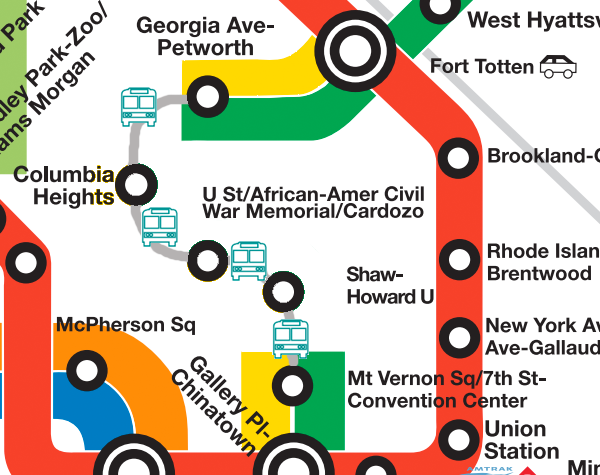
Temporarily closing a segment of the Green Line might ironically improve service for some this weekend. WMATA announced that it will close the Shaw, U Street, and Columbia Heights stations this weekend for scheduled track maintenance.
The stations will close at 10 pm Friday and won’t reopen until Tuesday morning’s normal opening time (Monday is a holiday). A similar closure will be in place on the Orange Line between East and West Falls Church stations as Metro works to connect the new Silver Line.
In the meantime, Metro will operate free shuttles along the route to ferry passengers through this service gap. Ironically, these shuttles may sometimes operate more frequently than the rail service would on a typical weekend.
Metro instituted a similar closure along a section of the Red Line on Labor Day weekend. On that weekend, we went to have brunch at a friend’s house in the Brookland neighborhood. During that time, Metro shuttles were running down his street every 2 minutes. Many of the buses were nearly empty, but for a moment we were jealous at the thought of transit service every 2 minutes.
Likewise, if WMATA keeps similarly short headways for the shuttles this weekend, the agency might actually enhance mobility between the Convention Center, Shaw, U Street, Columbia Heights, and Petworth.
One of Metro’s main shortcomings is that riding during non-rush periods, especially on weekends or at night, can entail waiting on platforms for as much as 24 minutes. This is an unacceptably low level of service, but our region lacks the political leadership to set a minimum level of transit service the way we do for utilities.
In DC, where 37% of households lack a car, the mayor and council chairman drive luxury cars at taxpayer expense, and other councilmembers receive free parking in front of the Wilson Building.
In the abstract, our leaders may appreciate the importance of frequent service, but nothing drives home the point like waiting on a Metro platform with 100 other people only to watch a packed train arrive half an hour later.
Though buses can’t match the speed and comfort of rail service, the frequency of bus shuttles this weekend might prove to be a significant, though temporary, transit improvement.
Carless in LeDroit
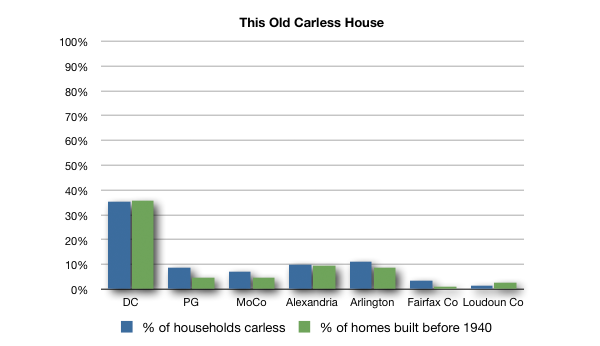
Source: U.S. Census Bureau
Among the nicest features of LeDroit Park are its walkability and its proximity to downtown. We can bike downtown to work in 15 minutes, or if it’s raining, take the bus or the metro and be there in 25 minutes. The restaurants, shops, and bars along U Street are only a short walk away.
The notion that it is easy to live in LeDroit Park without a car consistently confounds many suburbanites, but our variety of transportation options is no accident.
Our neighborhood is just outside the original L’Enfant city. In L’Enfant’s time, the main form of transportation was the human foot, so a city designed from scratch, like Washington, had to be relatively flat, like Washington, and compact, like Washington. Horse-drawn streetcars made commuting across the city easier, and electric streetcars eased the daily climb to neighborhoods like Columbia Heights and Mount Pleasant.
After World War II, housing construction exploded, particularly suburban housing construction. The suburban housing model was— and, for the most part, still is— based on several main principles, most significantly, the uniformity of housing sizes (usually large) and the separation of residential and commercial uses. Both larger lots and the separation of uses create longer distances between any two points, requiring a greater effort to go between home, work, and the grocery store.
These longer distances between daily destinations made walking impractical and the lower population densities made public transit financially unsustainable. The only solution was the private automobile, which, coincidentally, benefited from massive government subsidies in the form of highway building and a subsidized oil infrastructure and industry.
LeDroit Park was founded in 1873 and the first wave of single-family and duplex houses designed by James McGill soon followed. The second housing wave brought rowhouses to LeDroit Park, but most of the neighborhood was finished in the early twentieth century long before the dominance of the automobile.
Notice this 1908 photo of the 400 block of U Street in LeDroit Park. You’ll see four people, but only one car.

It’s no coincidence that our neighborhood’s founding, long before the automobile age, relates to its walkability and abundance of transit options. In fact, when we look at the regional Census data, we find a strong relationship between the age of the housing stock and the rate of households without a car.
The only other factor that might influence the rate of carlessness is income, but the closeness of the carless rate and the pre-war housing stock rate is too glaring to ignore. There are plenty of middle-class people in Washington who choose to forgo a private car and the age of the neighborhood may be a strong indication of just how easy it is to live without a car.
Opposing Metro Cuts
At Thursday’s monthly meeting of ANC1B, the commissioners voted unanimously to oppose various cuts to Metro service. In fact the level of opposition was so high that the commissioners tripped over each other adding amendments to oppose specific cuts to service. Specifically, the commission voted to
- Oppose all cuts to the Yellow Line all the way through Fort Totten (in Ward 5)
- Oppose ending service at midnight.
- Oppose closing the Tenth Street entrance to the U Street Metro station.
Noting the urgency of the cuts, the commission promised to formalize its opposition in a letter to WMATA the next day.
It’s reassuring to see that at least some local leaders recognize the important of Metro to life in the District.
Opposing Metro Service Cuts
Have you ever waited 30 minutes for a Metro train? That may become the norm on evenings if WMATA has its way. The transit agency is proposing to close a $40-million budget gap for the current fiscal year with a variety of measures, including the elimination of some jobs, the closure of certain mezzanines (including Shaw’s R Street entrance) at night, and by the reduction of call-center hours among other things. The worst part of the proposal, however, involves the reduction of train frequencies in the early mornings, late-nights and on weekends. One part of the proposal also calls for eliminating the eight-car trains that run on the Orange and Green Lines.
Many transit and urban planning bloggers around town have are warning of the “death spiral” that occurs when public agencies sharply reduce the quality and reach of their core services. Since reducing the frequency of trains reduces the intrinsic value of the transit system, the cuts risk driving away customers, thus ensuring a vicious cycle of ridership declines and subsequent revenue declines and service cuts.
The proposed frequency reductions mean that on Saturdays, Metro will actually run less often than the subway of Los Angeles. Los Angeles!
Our ANC Commissioner Myla Moss (ANC1B01 – LeDroit Park) emailed Councilmember Jim Graham (D – Ward 1) criticizing WMATA’s plan to close Shaw’s R Street entrance (the south entrance) late at night. Though we see how mezzanine closures will inconvenience a few riders by a few minutes at a few stations, we believe the real disservice is happening on the platforms: reducing train frequency will inconvenience all riders at every station.
Mr. Graham, we should remind you, is also the chairman of the WMATA board, which will hold a hearing and vote on the cuts on January 7. We have already emailed Mr. Graham to alert him to the dangers in some of the proposed cuts. We encourage you to let him know what you think.
Jim,
Can you imagine waiting 30 minutes for a Metro train to arrive? WMATA’s budget-cut proposal will leave many riders doing just that.
I’m worried that WMATA’s proposal to drastically cut rail and bus service is a terrible mistake that may lead to a “death spiral” in ridership and revenue. The proposed cuts to train and bus frequency will further turn off riders from the system, since reducing service makes the system intrinsically less valuable at a time when the District’s population is rising.
Your constituents in Ward One, a ward with some of the city’s highest population densities and lowest rates of car-ownership, will suffer greatly from reduced mobility options.
I urge you to vote against the proposal and request that WMATA management return with other options (e.g. fare increases, pay/benefit freezes, further staff reductions, entrance closings) that do not sacrifice the system’s core mission of providing decent mass-mobility.
Let us not follow the mistake of New York City, which, when faced with tax revenue shortfalls in the 1970s, reduced basic city services sharply. The reduction in services (park cleanings, street repairs, street sweepings, etc.) reduced the city’s attractiveness and further exacerbated the city’s financial woes— why stay in the city if the services are declining? Please do not let Metro (and DC, by extension) suffer a similar fate. Your constituents (and I am one of them) are heavily reliant on convenient and frequent transit service, which gives the District a competitive advantage over other cities and over the surrounding jurisdictions.
Eric Fidler
LeDroit ParkP.S. I am willing to pay a reasonable fare increase to avoid service cuts.
P.P.S. These proposed cuts will make trains less frequent than they are in Los Angeles, Boston, Philadelphia, Chicago, Montreal, Toronto, and New York. I can’t imagine a world in which even L.A. has better train service than Washington.
Let’s hope the board avoids these core-service reductions.

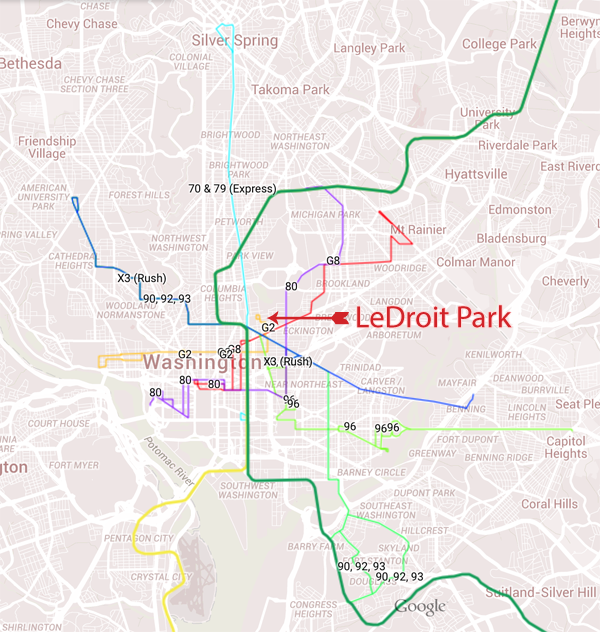

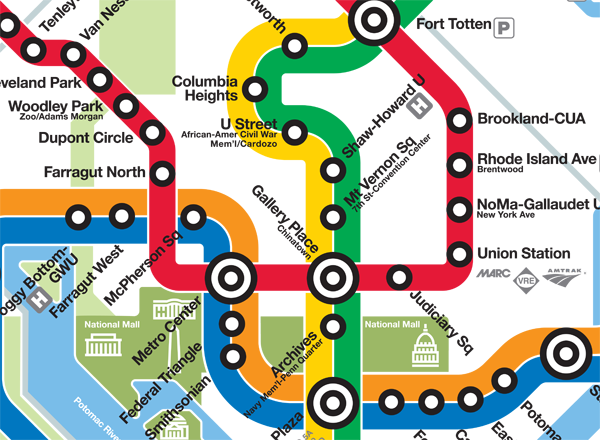








Recent Comments